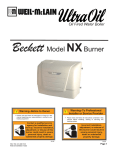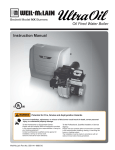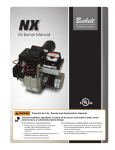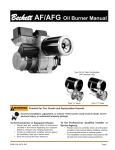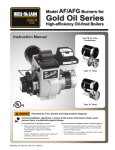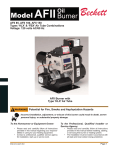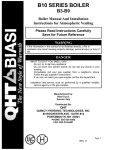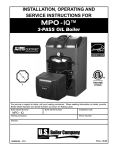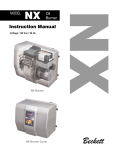Download Weil-McLain CG10 Specifications
Transcript
Oil Fired Water Boiler Beckett Model NX Burner ! WARNING Potential for Fire, Smoke and Asphyxiation Hazards Incorrect installation, adjustment, or misuse of this burner could result in death, severe personal injury, or substantial property damage. To the Homeowner or Equipment Owner: • • • Please read and carefully follow all instructions provided in this manual regarding your responsibilities in caring for your heating equipment. Contact a professional, qualified service agency for installation, start-up or service work. READ THESE INSTRUCTIONS AND SAVE FOR FUTURE REFERENCE. WM RWB 550-141-996/806 6104 WMNX To the Professional, Qualified Installer or Service Agency: • • Please read and carefully follow all instructions provided in this manual before installing, starting, or servicing this burner or heating system. The Installation must be made in accordance with all state and local codes having jurisdiction. Page 1 Page 2 RWB 6104 WMNX Table of Contents General Information Hazard Definitions ........................................................................................................................................ 4 Owner’s Responsibility ................................................................................................................................ 4 Information To Be Used Only By Qualified Service Technicians Weil-McLain Burner Specifications ........................................................................................................... 5 NX Burner Specifications for Weil-McLain Ultra Oil Burners ........................................................................ 5 General Information ......................................................................................................................................... 6 General Information………………………………………………………….. ......................................................... 6 Notice Special Requirements ........................................................................................................................... 6 Certifications/approvals ................................................................................................................................... 6 Inspect/Prepare Installation Site................................................................................................................. 6 Clearances to Burner and Appliance............................................................................................................... 6 Inspect Chimney or Direct Vent System ......................................................................................................... 6 Combustion Air Supply..................................................................................................................................... 7 Safety Shutoff for Direct Vent System............................................................................................................. 8 Direct/Sidewall Venting Application ................................................................................................................ 8 Mounting Dimensions ....................................................................................................................................... 8 Installing the Oil Tank and Supply System ..................................................................................................... 9 Fuel Supply Level with or Above Burner ........................................................................................................ 9 Fuel Line Installation....................................................................................................................................... 10 Wiring Connection Diagram ........................................................................................................................... 10 Start the Burner and Set Combustion .................................................................................................... 12 Start-up and Initial Settings............................................................................................................................ 12 Set Combustion with Test Instruments ......................................................................................................... 13 Cover Installation ............................................................................................................................................ 14 Trained Service Technician’s Regular Maintenance ......................................................................... 14 Removing Nozzle Line for Service................................................................................................................. 15 Nozzle Installation ........................................................................................................................................... 15 Check/Adjust Electrodes ................................................................................................................................ 16 Check Retention Head Alignment and Cad Cell Sighting............................................................................ 16 Check/Adjust “Zero” Calibration ................................................................................................................... 16 Blower Wheel Replacement ........................................................................................................................... 17 Shutting the Burner Off .................................................................................................................................. 17 Replacement Parts Diagram .................................................................................................................. 18/19 Replacement Parts Diagram........................................................................................................................... 18 Replacement Parts List................................................................................................................................... 19 Beckett Limited Warranty Information ................................................................................................... 20 RWB 6104 WMNX Page 3 General Information General Information To the Owner: Thank you for purchasing a Beckett NX burner for use with your heating appliance. Please pay attention to the Safety Warnings contained within this instruction manual. READ THESE INSTRUCTIONS AND SAVE FOR FUTURE REFERENCE. Your NX burner will provide years of efficient operation if it is professionally installed and maintained by a qualified service technician. If at any time the burner does not appear to be operating properly, immediately contact your qualified service agency for consultation. We recommend annual inspection/service of your oil heating system by a qualified service agency. • Hazard Definitions ! Indicates an imminently haz- DANGER ardous situation, which, if not avoided, will result in death, serious injury, or property damage. Indicates a potentially hazardous situation, which, if not avoided, could result in death, severe personal injury, and/or substantial property damage. ! WARNING Indicates a potentially hazardous situation, which, if not avoided, may result in personal injury or property damage. ! CAUTION Within the boundaries of the hazard warning, there will be information presented describing consequences if the warning is not heeded and instructions on how to avoid the hazard. NOTICE NOTICE Intended to bring special attention to information, but not related to personal injury or property damage. Page 4 ! WARNING Owner’s Responsibility Incorrect installation, adjustment, and use of this burner could result in severe personal injury, death, or substantial property damage from fire, carbon monoxide poisoning, soot or explosion. Contact a professional, qualified service agency for the installation, adjustment and service of your oil heating system. This work requires technical training, trade experience, licensing or certification in some states and the proper use of special combustion test instruments. Please carefully read and comply with the following instructions: • Never store or use gasoline or other flammable liquids or vapors near this burner or appliance. • Never attempt to burn garbage or refuse in this appliance. • Never attempt to light the burner/appliance by throwing burning material into the appliance. • Never attempt to burn any fuel not specified and approved for use in this burner. • Never restrict the air inlet openings to the burner or the combustion air ventilation openings in the room. ! WARNING Professional Service Required Incorrect installation, adjustment, and use of this burner could result in severe personal injury, death, or substantial property damage from fire, carbon monoxide poisoning, soot or explosion. Please read and understand the manual supplied with this equipment. This equipment must be installed, adjusted and put into operation only by a qualified individual or service agency that is: • Licensed or certified to install and provide technical service to oil heating systems. • Experienced with all applicable codes, standards and ordinances. • Responsible for the correct installation and commission of this equipment. • Skilled in the adjustment of oil burners using combustion test instruments. The installation must strictly comply with all applicable codes, authorities having jurisdiction and the latest revision of the National Fire Protection Association Standard for the installation of Oil-burning Equipment, NFPA 31 (or CSA-B139 and CSA-B140 in Canada). Regulation by these authorities take precedence over the general instructions provided in this installation manual. RWB 6104 WMNX Weil-McLain Burner Specifications NX Burner Specifications for WeilMcLain Ultra Oil Boilers NOTICE Fozen Plumbing and Water Damage Hazard. Unoccupied residences in severly cold weather could experience frozen plumbing in just a few hours if the heating system fails for any reason. Consult your HVAC contractor for effective preventive protection, such as electronic monitoring systems with 24/7 dial-up capability. The table below provides burner specifications and starting air settings for NX burners applied to WeilMcLain Model UO boilers. Follow all instructions in this burner manual, the boiler manual and the fuel pump literature to install, setup and service the burner. NOTICE The remainder of this manual contains Information to be used ONLY by a qualified Service Technician. Table 1. Burner Configurations - Verify that burner specification number (on burner carton) and configuration agrees with information below. Boiler Model Burner Spec Firing Rate (GPH) Air Tube Combination Insertion Primary Nozzle Alternate Nozzle Fuel Pump Pressure (psig) Head/Air Adjustment Plate Setting UO-3 CV WL5703 (See Note1) 0.80 NX70LC 1-3/4” 0.65 X 60oA Delavan 0.65 X 70oB Hago 150 1.75 UO-3 CV WL5703 1.00 NX70LC 1-3/4” 0.75 X 60oB Hago 0.75 X 60oB Delavan 175 2.50 UO-4 CV WL5704 1.20 NX90LB 3-1/2” 1.00 X 70oB Hago 1.00 X 70oB Delavan 140 4.00 UO-5 CV WL5705 1.40 NX90LD 3-1/2” 1.10 X 70oB Hago 1.10 X 70oB Delavan 160 1.50 UO-3 DV WL5803 (See Notes1 & 2) 0.80 NX70LC 1-3/4” 0.65 X 60oA Delavan 0.65 X 70oB Hago 150 1.75 UO-3 DV WL5803 (See Note 2) 1.00 NX70LC 1-3/4” 0.75 X 60oB Hago 0.75 X 60oB Delavan 175 2.50 UO-4 DV WL5804 (See Note 2) 1.20 NX90LB 3-1/2” 0.85 X 60oW Delavan 0.85 X 60oW Hago 190 4.00 UO-5 DV WL5805 (See Note 2) 1.40 NX90LD 3-1/2” 1.10 X 70oB Hago 1.10 X 70oB Delavan 160 1.50 1) Shipped as 1.0 GPH Burner Configuration. The 0.80 GPH input uses same burner as 1.0 GPH input. Replace nozzle, adjust pump pressure and Head/Air setting as shown above and install 14”x16” blanket on combustion chamber floor. (See Maintenance Section for Nozzle Replacement details.) 2) Direct Vent Boilers require that a combustion chamber blanket be installed (blanket supplied with burner). Figure 1. Burner label location RWB 6104 WMNX Page 5 General Information Certifications/approvals General Information Underwriters Laboratories has certified this burner to comply with ANSI/UL 296 and CSA-B139. Low sulfur #1 and #2 fuel oils reduce heat exchanger deposits with all burners compared to the standard fuels. Reduced deposits extend the service interval for cleaning and improve the efficiency of the appliance over time. Low sulfur fuels reduce particulate and oxides of nitrogen emissions as well. The Oilheat Manufacturers’ Association recommends these fuels as the preferred fuels for this burner. Table 2. – Burner Specifications Capacity Firing rate: 0.40 – 1.35 GPH LB & LC Input: 56,000 – 189,000 Btu Capacity Firing rate: 1.10 - 1.75 GPH LD & LF Input: Fuels U. S No. 1 or No. 2 heating oil only 154,000 – 245,000 Btu/h ...........(ASTM D396) Canada No. 1 stove oil or No. 2 .........furnace oil only ! Electrical CAUTION • DO NOT USE GASOLINE, CRANKCASE OIL, OR ANY OIL CONTAINING GASOLINE. Power supply: 120 VAC, 60 Hz, single phase Operating load: 5.8 Amps max Motor: 1/7 hp, 3450 rpm, NEMA 48M Inspect/Prepare Installation Site frame PSC rotation CCW Clearances to Burner and Appliance • when facing shaft end Ignition: Continuous duty solid-state igniter Fuel pump Outlet pressure ...... Note 1 Air tube ATC code .......See Table 3 Dimensions Height (maximum): 12-1/2 inches (with cover) Width (maximum): 15 inches Air tube diameter: 3-1/4 inches *Note 1. See appliance manufacturer’s burner specifications for recommended outlet pressure. Table 3. – Air Tube Combinations (ATC) Firing rate Head Inspect Chimney or Direct Vent System ! WARNING Fire, Smoke & Asphyxiation Hazard • ATC codes for usable air tube • lengths: • (gph) (min-max) Provide space around burner and appliance for ease of service and maintenance. Check the minimum clearances against those shown by the appliance manufacturer and by applicable building codes. • Depth: 9-1/4 inches 5” 7” 9” 0.40-1.35 9-Slot NX50LB NX70LB NX90LB 0.40-1.35 6-Slot NX50LC NX70LC NX90LC 1.10-1.75 9-Slot NX50LD NX70LD NX90LD 1.10-1.75 6-Slot NX50LF NX70LF NX90LF • • Notice Special Requirements • • • • Page 6 THE INSTALLATION OF A BURNER SHALL BE IN ACCORDANCE WITH THE REGULATIONS OF AUTHORITIES HAVING JURISDICTION. For recommended installation practices in the U.S. refer to the latest edition of NFPA 31. (CSAB139 and CSA-B140 in Canada. Concealed damage — If you discover damage to the burner or controls during unpacking, notify the carrier at once and file the appropriate claim. When contacting Beckett for service information — Please record the burner serial number (and have available when calling or writing). You will find the serial number on the silver label located on the left rear of the burner. Refer to Figure 1. Carefully inspect the chimney or exhaust vent system. Make sure it is properly sized and in good working condition. Follow the instructions supplied by the appliance manufacturer. The installation must strictly comply with all applicable codes, authorities having jurisdiction and the latest revision of the National Fire Protection Association Standard NFPA 31 for the installation of chimneys and vent sizing, (or CSA-B139 and CSA-B140 in Canada). Regulation by these authorities take precedence over the general instructions provided in this installation manual. 1. Starting with minimum gph firing rate, the minimum size recommended is 6” flue pipe with 8” X 8” inside chimney, unless specified otherwise by the appliance manufacturer. RWB 6104 WMNX Figure 2 – Chimney Design - Above the Roof Inspect/Prepare Installation Site NOTE: Correct chimney design is shown by dotted lines. Incorrect chimney design, as shown by the solid lines, may result in downdrafts. 2. A chimney flue shall extend at least 3 feet above the highest point at which the chimney comes in contact with the roof, and not less than 2 feet above the highest roof surface or structure within 10 feet horizontally of the chimney. Refer to Figure 2. Therefore, it is strongly recommended that an approved insulated stainless steel liner be installed. • 3. Any accumulation of soot or debris in chimney offsets should be removed Combustion Air Supply Information • 4. Any obstructions such as a protruding joint or a piece of broken tile wedged in the chimney should be removed. 5. No other appliance connection should be made to the same flue pipe. 6. The flue pipe should have an upward pitch toward the chimney of at least 1/4” per foot of length. It should fit tightly and should not project into the chimney. 7. Any leakage between tiles, around clean-out doors, or around the vent pipe should be sealed. ! For those installations not requiring a chimney, such as through-the-wall vented appliances, follow the instructions given by the appliance and power venter (if used) manufacturers. WARNING Adequate Combustion and Ventilation Air Supply Required Failure to provide adequate air supply could seriously affect the burner performance and result in damage to the equipment, asphyxiation, explosion or fire hazards. • • The burner cannot properly burn the fuel if it is not supplied with a reliable combustion air source. Follow the guidelines in the latest editions of the NFPA 31 and CSA-B139 regarding providing adequate air for combustion and ventilation. INSULATED STAINLESS STEEL CHIMNEY LINERS The new designs of high efficiency oil furnaces and boilers in conjunction with flame retention oil burners are more efficient. One result of increased efficiency is lower flue gas temperatures. As flue gases rise in the chimney, they will cool and condense when they reach the dew point. The condensation will mix with the sulphur in the flue gases creating sulphuric acid. The acid will attack the chimney mortar, brick and clay liners causing corrosion, deterioration and blockage of the chimney. Eventually the blockage could prevent exhausting the flue gases. Instead, the flue gases could vent out the barometric damper into the living space. RWB 6104 WMNX See NFPA Standard 31 for complete details. Appliances located in confined spaces: All confined spaces should have two (2) permanent openings; one near the top of the enclosure and one near the bottom of the enclosure. Each opening must have a free area of not less than one (1) square inch per 1,000 BTU’s per hour of the total input rating of all appliances within the enclosure. The openings should have free access to the building interior, which should have adequate infiltration from the outside. Page 7 Inspect/Prepare Installation Site Exhaust fans and other air-using devices: Size air openings large enough to supply all air-using devices in addition to the minimum size required for combustion air. If there is any possibility of the equipment room developing a negative pressure due to exhaust fans, clothes dryers, etc., either pipe combustion air directly to the burner or provide a sealed enclosure for the burner and supply it with its own combustion air supply. • • • The direct vent blocked flue safety shut off system, refer to Figure 3, shuts down the burner if the exhaust flue is blocked and/or if the air inlet is blocked. It recognizes a blocked flue by sensing excessive pressure in the combustion chamber. It recognizes a blocked inlet by sensing excessive vacuum in the air inlet adapter. • Direct/Sidewall Venting Application For direct vent installations, follow instructions provided with appliance and direct vent system. Outside combustion air is required for direct venting. WARNING Connect Outside Air Duct to NX Adapter Failure to install adapter properly could result in impaired combustion, appliance soot-up, puffback of smoke, and fire or asphyxiation hazards. Safety Shutoff for Direct Vent System This system meets the requirements for a blocked flue or blocked combustion air inlet per CSA Standard B140.0. It is designed to interrupt the cad cell circuit and allow the control to shut down the burner. • ! The outside air adapter must be installed by strictly following the kit installation instructions. DO NOT attempt to install outside air piping without using the outside air adapter and instructions provided. Abundant fresh air is required for proper combustion. When installing an NX outside air adapter (Beckett Part Number 52018U), refer to the instruction sheet supplied with the adapter. This kit allows combustion air to be piped directly to the burner. The NX outside air adapter kit may also be used for chimney vent applications that require outside combustion air. • Mounting dimensions 1. When using the Beckett universal adjustable flange, mount the air tube at a 2° downward pitch unless otherwise specified by the appliance manufacturer. Figure 4. – Mounting Burner in Appliance If space between burner ! WARNING Follow the Outside Air Kit Instructions Exactly Failure to comply could result in impaired combustion, appliance soot-up, puffback of smoke, and fire or asphyxiation hazards. • air tube and opening exceeds 1/2 inch, pack burner opening with ceramic fiber refractory. Tilt down 2 o Do not attempt to install outside air piping to the burner without using the outside air kit and instructions. SK8745 Figure 3. Pressure Switch Installation Page 8 RWB 6104 WMNX 2. Verify that the air tube installed on the burner provides the correct insertion depth. See Figure 4. 3. The end of the air tube should normally be ¼” back from the inside wall of the combustion chamber. Never allow the leading edge of the head assembly to extend into the chamber, unless otherwise specified by the heating appliance manufacturer. Carefully measure the insertion depth when using an adjustable flange. Verify the insertion depth when using a welded flange. Installing the Oil Tank and Supply System • ! WARNING Oil Leak and Fire Hazard ! WARNING CAUTION Do Not Use Teflon Tape Damage to the pump could cause impaired burner operation, oil leakage and appliance soot-up. • • • Never use Teflon tape on fuel oil fittings. Tape fragments can lodge in fuel line components and fuel unit, damaging the equipment and preventing proper operation. Use oil-resistant pipe sealant compounds. Note: to determine the proper fuel line size, refer to the fuel pump manufacturer’s instructions provided with the burner. Refer to Figure 5 or Figure 6 for typical installation layouts. Do Not Install By-pass Plug with 1-Pipe System Failure to comply could cause immediate pump seal failure, pressurized oil leakage and the potential for a fire and injury hazard. • The burner is shipped without the by-pass plug installed. Install the by-pass plug in two-pipe oil supply systems ONLY. • ! CAUTION Oil Supply Pressure Control Required Damage to the filter or pump seals could cause oil leakage and a fire hazard. • • Install the oil tank following applicable standards in the U.S. by referring to the latest edition of NFPA 31 or CSA-B139 & CSA-B140 in Canada, and all authorities having jurisdiction. ! Fuel supply level with or above burner • • • The oil supply inlet pressure to the burner cannot exceed 3 psig. Insure that a pressure limiting device is installed in accordance with the latest edition of NFPA 31. Do NOT install valves in the return line. Gravity Feed Systems: Always install an anitsiphon valve in the oil supply line or a solenoid valve (RWB Part # 2182602U) in the pump/nozzle discharge tubing to provide backup oil flow cut-off protection. The burner may be equipped with a single-stage fuel unit for these installations. Connect the fuel supply to the burner with a single supply line if you want a one-pipe system (making sure the bypass plug is NOT installed in the fuel unit.) Manual bleeding of the fuel unit is required on initial startup. If connecting a two-pipe fuel supply, install the fuel unit bypass plug. Figure 5. – Inside Tank Gravity Feed System Fuel Line Valves and Filter Install two high quality, oil duty rated, fusible handle design shutoff valves in accessible locations on the oil supply line. Locate one close to the tank and the other close to the burner, upstream of the filter for service access. Install a generous capacity filter inside the building between the fuel tank shutoff valve and the burner, locating both the filter and the valve close to the burner for ease of servicing. Filter should be rated for 50 microns or less. RWB 6104 WMNX Page 9 Wiring Connections Diagram • Figure 6. – Outside Buried Tank-Lift System ! WARNING Electrical Shock Hazard Electrical shock can cause severe personal injury or death. • • • NOTICE To further protect the fuel supply system and reduce nozzle orifice plugging with firing rates below 0.75 gph, a dual filtration system can be installed. This typically consists of a 50 micron primary filter, located near the fuel tank and a secondary filter rated for at least 10 microns located near the burner. Fuel supply below the level of the burner – • When the fuel supply is more than eight feet below the level of the burner, a two-pipe fuel supply system is required. Depending on the fuel line diameter and horizontal and vertical length, the installation may also require a two-stage pump. Consult the fuel unit manufacturer’s literature, included with the burner, for lift and vacuum capability. Disconnect electrical power before installing or servicing the burner. Provide ground wiring to the burner, metal control enclosures and accessories. (This may also be required to aid proper control system operation.) Perform all wiring in compliance with the National Electrical Code ANSI/NFPA 70 (Canada CSA C22.1) Refer to the appliance manufacturer’s wiring diagram prior to connecting the burner wiring. All wiring must be in accordance with the latest revision of National Electric Code NFPA 70 and all local codes and regulations. The R7184 primary control with valve-on delay and burner motor-off delay, shown in Figure 6, requires a constant 120 volt AC power source supplied to the black wire on the control. (Referring to Figure 8 and the appliance manufacturer’s instructions.) The red wire goes to the appliance limit circuit. Please note that other control manufacturers may use different wire colors for power and limit connections. Figure 7. – Burner Connections. Fuel line installation – • • Continuous lengths of heavy wall copper tubing are recommended. Always use flare fittings. Never use compression fittings. • Always install fittings in accessible locations. Proper routing of fuel lines is required to prevent air cavitation and vibration. SK9806 Page 10 RWB 6104 WMNX Start the Burner and Set Combustion Figure 8. – Typical Burner Wiring for R7184 Control. Refer to the appliance manufacturer’s wiring diagram for actual specifications. Burner Sequence of Operation for R7184 Control. 1. STANDBY. The burner is idle, waiting for a call for heat. When a call for heat is initiated, there is a 310 second delay while the control performs a safe start check. 2. VALVE-ON DELAY. The ignition and motor are turned on for a 15 second valve-on delay. 3. TRIAL FOR IGNITION (TFI). The fuel valve is opened. A flame should be established within the 15 second lockout time. 4. LOCKOUT. If flame is not sensed by the end of the TFI, the control shuts down on safety lockout and must be manually reset. If the control locks out three times in a row, the control enters restricted lockout. 5. IGNITION CARRYOVER. Once flame is established, the ignition remains on for 10 seconds to ensure flame stability before turning off. If the control is wired for intermittent duty ignition, the ignition unit stays on the entire time the motor is running. 6. RUN. The burner runs until the call for heat is satisfied. The burner is then sent to burner motor off delay, if applicable, or it is shut down and sent to standby. RWB 6104 WMNX 7. RECYCLE. If the flame is lost while the burner is firing, the control shuts down the burner, enters a 60 second recycle delay, and then repeats the above ignition sequence. If flame is lost three times in a row, the control locks out to prevent cycling with repetitious flame loss due to poor combustion. 8. BURNER MOTOR-OFF DELAY. The fuel valve is closed and the burner motor is kept on for the selected motor-off delay time before the control returns the burner to standby. 61351 Page 11 Start the Burner and Set Combustion • WARNING Explosion and Fire Hazard ! Failure to follow these instructions could lead to equipment malfunction and result in heavy smoke emission, soot-up, hot gas puffback, fire and asphyxiation hazards. Start-up and Initial Settings 1. Open the shutoff valves in the oil supply line to the burner. 2. Referencing Figure 9, verify and/or set the Head/Air Adjustment Pointer to the value specified by the Appliance Manufacturer. Refer to Table 1. (This is an initial air setting for the pump bleeding procedure only.) Calibrated test instruments must be used for the final head/ air adjustment. • • • 3. Adjust the thermostat or temperature controller to call for heat. (Note: return controller(s) to the original settings upon completion of burner installation or service.) • • 4. Close the line voltage switch to start the burner. If the burner does not start within the 3 to 10 second safety start check timing, you may have to reset the safety switch on the burner primary control. • b. Turn the adjustment screw until the reading is set to zero. (Mid-point of pointer should line up with zero. c. Turn the adjustment screw counterclockwise to adjust the plate with the pointer to the zero position. d. Slide the nozzle line assembly forward until the retention head engages the fixed stops in the retention ring at the end of the air tube. Refer to Figure 10. e. Tighten the zero setting locking nut. f. The rear door must be closed. The adjustment screw may now be turned clockwise to adjust the head/air setting. g. Turn the adjusting screw to a setting 1/2 number lower than the proper setpoint as indicated in Table 1. Then turn the adjusting screw counterclockwise to the proper setting. h. Tighten the locking nut after the head/air setting has been adjusted. 5. Bleed the air from the fuel pump as soon as the burner motor begins rotating. 6. Prepare for combustion tests by drilling a 1/4” sampling hole in the flue pipe between the appliance and the barometric draft regulator. Seal this hole when testing is complete. (See appliance manufacturer’s instructions for location.) 7. Check/Adjust the Zero Calibration for the Head/ Air Adjustment Mechanism. Refer to Figure 9. a. Slightly loosen the zero setting locking nut. Figure 9. Head/air Adjustment Plate Assembly Set Combustion with Test Instruments • Zero Setting Locking Nut ! CAUTION OIL-BURNING EQUIPMENT SHALL BE CONNECTED TO FLUES HAVING SUFFICIENT DRAFT AT ALL TIMES TO ASSURE SAFE AND PROPER OPERATION OF THE BURNER. Pointer Adjustment Screw Page 12 Do not attempt to start the burner when excess oil has accumulated in the appliance, the appliance is full of vapor, or when the combustion chamber is very hot. Do not attempt to re-establish flame with the burner running if the flame becomes extinguished during start-up, venting, or adjustment. Vapor-Filled Appliance: Allow the unit to cool off and all vapors to dissipate before attempting another start. Oil-Flooded Appliance: Shut off the electrical power and the oil supply to the burner and then clear all accumulated oil before continuing. If the condition still appears unsafe, contact the Fire Department. Carefully follow their directions. Keep a fire extinguisher nearby and ready for use. Am52000 1. Allow the burner to run for approximately 5 to 10 minutes. RWB 6104 WMNX Set Combustion using Test Instruments NOTICE The NX burner has a reduced diameter air tube, precision-designed air throttle cup and combustion head for improved performance. This design provides very accurate control of the air/fuel ratio, but the light reaching the cad cell through small holes in these components is limited. Because of this, the average cad cell resistance may be higher than conventional burners with larger openings. 2. Set the stack or over-fire draft to the level specified by the appliance manufacturer. • • • Natural Draft Applications; typically over-fire draft is -0.01” or -0.02” w.c. Direct Venting; typically may not require draft adjustment. High Efficiency/Positive Pressure Appliances; also vary from traditional appliances (see manufacturer’s recommendations). 3. Follow these five steps to properly adjust the burner: Step 1: Adjust the head/air until a trace of smoke is achieved. This can be accomplished by turning the screw on the head/air adjustment plate assembly to increase air (CCW) or decrease air (CW). Step 2: At the trace of smoke level, measure the CO2 (or O2) . This is the vital reference point for further adjustments. Example: 13.5% CO2 (2.6% O2) Step 3: Increase the air to reduce the CO2 by 1.5 to 2 percentage points. (O2 will be increased by approximately 2.0 to 2.7 percentage points.) Example: Reduce CO2 from 13.5% to 11.5% (2.6% to 5.3% O2). Step 4: Recheck smoke level. It should be Zero. This procedure provides a margin of reserve air to accommodate variable conditions. If the draft level has changed, recheck the smoke and CO2 levels and readjust burner, if necessary. Step 5: Once the combustion has been set, tighten the lower acorn nut and splined nut on the air adjustment assembly. See Figure 9. 4. Chimney Vent Systems: Install the burner cover and repeat Steps 2 and 4 above. If CO2 increases (O2 decreases), remove the cover and adjust the air setting so the CO2 (O2) with the cover installed meets the requirements of Step 3. 5. Direct Vent Systems with outside air ducted to burner: Install the burner cover. 6. Start and stop the burner several times to ensure satisfactory operation. Test the primary control and all other appliance safety controls to verify that they function according to the manufacturer’s specifications. Figure 10. – Nozzle Line/Head/Air Tube Assembly (Low firing rate shown.) Retention Head Head Support Legs Electrode Tips Electrode Clamp Electrode Bracket Electrode Insulator Electrode Extension Rods SK9666A Bulkhead Fitting SK9666A Nozzle Adapter Nozzle Stops in Retention Ring Throttle Cup Nozzle Line Throttle Ring Throttle Cup Hub Retention Ring RWB 6104 WMNX Page 13 Trained Service Technician’s Regular Maintenance Cover Installation • 1. Install the four cover mounting thumb screws in the cover mounting plate. 2. Install the cover over the mounting plate while aligning the side slots with the installed cover mounting screws. Figure 11. – Burner Cover SK9804A Trained Service Technician’s Regular Maintenance ! WARNING Annual Professional Service Required Tampering with or making incorrect adjustments could lead to equipment malfunction and result in asphyxiation, explosion or fire. • • • • DO NOT TAMPER WITH THE UNIT OR CONTROLS - CALL YOUR QUALIFIED SERVICE TECHNICIAN OR SERVICEMAN. To ensure continued reliable operation, a qualified service technician must service this burner annually. More frequent service intervals may be required in dusty or adverse environments. Operation and adjustment of the burner requires technical training and skillful use of combustion test instruments and other test equipment. The following guidelines are provided for routine maintenance. Replace the oil supply line filter. The line filter cartridge must be replaced to avoid contamination of the fuel pump and nozzle. Inspect the oil supply system. All fittings should be tight and leak-free. The supply lines should be free of water, sludge and other restrictions. Page 14 Remove and clean the pump strainer if applicable. Replace the used nozzle with a new nozzle that conforms to the appliance manufacturer’s specifications. Clean and inspect the electrodes for damage, replacing any that are cracked or chipped. Check electrode tip settings. Replace electrodes if tips are rounded. Inspect the igniter spring contacts. Clean the cad cell lens surface, if necessary. Make sure Low Firing Rate Baffle is in place if required for the burner application. Omitting the baffle can result in unacceptable burner combustion. Inspect all gaskets. Replace any that are damaged or would fail to seal adequately. Clean the blower wheel, air inlet, air guide, retention head, throttle cup and throttle ring of any lint or foreign material. Use a clean soft cloth with a degreaser to clean any accumulated soot or oil stains from the throttle cup sight windows. ! WARNING Do Not Puncture, Scratch, or Remove Flame Sighting Windows If a window is punctured, significantly scratched or removed from the throttle cup, the burner performance could be impaired, resulting in safety lockout, appliance soot-up, equipment damage, hot gas puff-back and asphyxiation hazard. • • Use a clean soft cloth and degreaser, on an annual basis, to remove any build-up or dark stains from the windows. If damaged, replace the nozzle line assembly with an assembly that has a windowed throttle cup. Check motor current. The amp draw should not exceed the nameplate rating. Check all wiring for secure connections or insulation breaks. Check the pump pressure and cutoff function. Check primary control safety lockout timing. Check ignition system for proper operation. Inspect and clear the vent system and chimney of any soot accumulation or other restriction. Clean all flue passages and flue pipe. Replace corroded or damaged pipes. Clean the appliance thoroughly according to the manufacturer’s recommendations. Check the burner performance. Refer to the section “Set combustion with test instruments”. It is good practice to keep a record of the service performed and the combustion test results. RWB 6104 WMNX Trained Service Technician’s Regular Maintenance Removing Nozzle Line for Service (Reference the Replacement Parts Diagram.) • ! 5. Loosen the two screws securing the rear door. Swing the door to the right and down. 6. Loosen the splined nut. WARNING Electrical Shock Hazard 7. Remove the nozzle line electrode and head assembly from the burner by drawing it straight back and out the rear door opening. The adjustment mechanism is still attached. Be careful not to damage the electrodes or insulators while handling. Electrical shock can cause severe personal injury or death. • • • Disconnect electrical power before installing or servicing the burner. Provide ground wiring to the burner, metal control enclosures and accessories. (This may also be required to aid proper control system operation.) Perform all wiring in compliance with the National Electrical Code ANSI/NFPA 70 (Canada CSA C22.1) 1. Before proceeding, turn off the main power switch to the burner. 2. Remove the burner cover by loosening the four thumb screws (two on each side of burner). 3. Disconnect the copper connector tube assembly from the nozzle line bulkhead fitting. 4. Loosen the two screws securing the igniter retaining clips and rotate both clips to release the igniter baseplate. The igniter should pop up and be supported by the prop spring. ! WARNING Correct Nozzle and Flow Rate Required 8. To replace the nozzle assembly, reverse the above procedure. Nozzle Installation • Perform the following steps when replacing a nozzle. ! Protect Nozzle from CAUTION Damage A damaged nozzle could cause impaired combustion, sooting, puffback of hot gases, smoke, oil leakage and potential fire or asphyxiation hazards. • • Use care when handling, removing and installing oil nozzles. Carefully follow the guidelines provided in this section. 1. Remove the nozzle line assembly to gain access to the nozzle. Incorrect nozzles and flow rates could result in impaired combustion, under-firing, over-firing, sooting, puff-back of hot gases, smoke and potential fire or asphyxiation hazards. 2. Use a 3/4” open-end wrench to hold the nozzle adapter. DO NOT attempt to remove or replace the nozzle without securing the adapter, as nozzle alignment could be seriously affected. Use only nozzles having the brand, flow rate (gph), spray angle and pattern specified by the appliance manufacturer or Beckett Residential Burner OEM Spec Guide, Part #6711. 3. Do not squeeze the electrodes when handling the nozzle line assembly. Excessive force could change the electrode tip settings or damage the ceramic electrode insulators. Follow the appliance manufacturer’s specifications for the required pump outlet pressure for the nozzle, since this affects the flow rate. • Nozzle manufacturers calibrate nozzle flow rates at 100 psig. • This burner utilizes pressures higher than 100 psig, so the actual nozzle flow rate will be greater than the gph stamped on the nozzle body. (Example: A 1.00 gph nozzle @ 140 psig = 1.18 gph) 4. Use a 5/8” open-end wrench to carefully remove the existing nozzle. For typical nozzle flow rates at various pressures see accompanying chart. 6. Protect the nozzle orifice and strainer when installing. If the orifice gets dirt in it or is scratched, the nozzle will not function properly. RWB 6104 WMNX 5. Inspect the nozzle adapter before installing the new nozzle. If it is grooved or scratched on the sealing surface, replace the nozzle line assembly. If the surface is damaged, oil could leak at the nozzle to adapter joint, causing serious combustion problems. Page 15 Trained Service Technician’s Regular Maintenance Nozzle Flow Rate by Size Figure 12. – Electrode tip gap and spacing Nozzle flow rate U. S. gallons per hour of No. 2 fuel oil when 5/32” GAP pump pressure (psig) is: Nozzle 125 140 psi 150 175 200 size psi (factory psi psi psi (rated 1/4” above nozzle center std.) at 100 psig) 0.40 0.45 0.47 0.49 0.53 0.56 0.50 0.56 0.59 0.61 0.66 0.71 0.60 0.67 0.71 0.74 0.79 0.85 0.65 0.73 0.77 0.80 0.86 0.92 0.75 0.84 0.89 0.92 0.99 1.06 0.85 0.95 1.01 1.04 1.13 1.20 0.90 1.01 1.07 1.10 1.19 1.27 1.00 1.12 1.18 1.23 1.32 1.41 1.10 1.23 1.30 1.35 1.46 1.56 1.20 1.34 1.42 1.47 1.59 1.70 1.25 1.39 1.48 1.53 1.65 1.77 1.35 1.51 1.60 1.65 1.79 - 1.50 1.68 1.77 1.84 - - 1.65 1.84 - - - - 1.75 - - - - - 7. To install a new nozzle, place a 3/4” open-end wrench on the nozzle adapter. Insert the nozzle into the adapter and secure finger tight. Finish tightening with a 5/8” open-end wrench. Use care to avoid bending the burner head support legs or electrodes. 8. Do not over-torque the nozzle when installing. This will cause deep grooves in the nozzle adapter, preventing a seal when a new nozzle is installed. 9. Carefully check and realign the electrode tips after replacing a nozzle, ensuring the electrode settings comply with Figure 12. 10. If the head was removed when replacing the nozzle, carefully reconnect the head to the nozzle adapter. Make sure to align the key in the support leg with the keyway in the nozzle adapter and to butt the head support to the nozzle adapter shoulder, see Figure 10. • Check/Adjust Electrodes Check the electrode tip settings, as shown in Figure 12. If necessary, adjust by loosening the electrode clamp screw (Figure 10) and slide/rotate the electrodes as necessary. When the adjustment is complete, securely tighten the clamp screw. SK9664 3/32” Nozzle-to-tip Spacing Note that if the throttle cup is moved be sure to reposition it with no gap between the nozzle adapter and hub. • Check Retention Head Alignment and Cad Cell Sighting (Refer to Figure 13.) The cad cell sighting holes in the throttle cup and the retention head must be aligned to allow the cad cell to detect the flame. Make sure the stamped key in the retention head collar lines up with the keyway in the nozzle adapter when mounting the retention head. Note that in specific applications, the retention head may not have a sighting hole. • Check/Adjust “Zero” Calibration On burners with factory-installed air tubes, the zero calibration has been factory set. Make sure the retention head (Figure 10) is securely against the stops in the retention ring when the adjustment plate pointer is at “0” (Figure 9). If the zero calibration has not been set, perform the following procedure: 1. Install the nozzle line, with the adjustment plate assembly attached, into the burner. 2. Install and tighten the rear door to hold the air adjustment plate assembly in position. 3. Slightly loosen the upper acorn nut, the splined nut, and the lower acorn nut. 4. Turn the air adjustment screw clockwise to adjust the plate with the pointer to the zero position. 5. Referring to Figure 10, slide the nozzle line assembly forward until the retention head engages the fixed stops in the retention ring at the end of the air tube. 6. Tighten the upper acorn nut securely. Page 16 RWB 6104 WMNX Figure 13. – Retention Head/Throttle Cup Alignment 7. The rear door must be kept tightly closed. The adjustment screw may now be turned to adjust the head/air setting. 8. Turn the adjusting screw to a setting ½ number lower than the proper set point as indicated in Table 1. Then turn the adjusting screw counterclockwise to the proper setting. Figure 14. – Blower wheel assembly 9. Tighten the splined nut and lower acorn nut after the head/air setting has been adjusted. • Blower Wheel Replacement For installation or replacement of a blower wheel, insure that there is a space between the blower wheel and the motor face of 0.115”. Refer to Figure 14. • Shutting the Burner Off SK9670 Turn off all electric power to the burner. Note: There could be more than one disconnect switch. ! CAUTION IF THE BURNER IS SHUT DOWN FOR AN EXTENDED PERIOD OF TIME, ALWAYS KEEP THE VALVE SHUT OFF. RWB 6104 WMNX Page 17 Replacement Parts Diagram Page 18 RWB 6104 WMNX Replacement Parts List For best performance specify genuine Beckett Item Description Part No. 1 Head/Air adjustment mechanism assembly 52000U 2 Air guide 101101U 3 Gasket, mounting flange (not shown) 32389 4 Air tube combination, (Includes Screws, air tube mounting #8 x 3/8) Specify 4396 replacement parts 20 PSC Motor, (Requires Mounting screws ¼ -20 x 7/8”) 21805U 4189 21 Primary control R7184P Valve-on/Motor Delay R7184P With Alarm Contacts 7457U 7458U 22 Retention head assembly, 6 -slot 51785U 23 Retention head assembly, 9 -slot 51815U 24 Splined nut 3666 25 Spring, igniter prop 32058U 26 Electrical box 5770 5 Blower wheel 2999U 6 Connector tube assembly, 11” 51127 7 Coupling 2454 8 Door, rear access 32119U 9 Electrode insulator kit 51811U 28 Cover, burner 32395U 10 CleanCut Fuel Pump, (Requires Mounting Screws ¼ -20 x 7/8”) 2184404U 4189 29 Mounting plate, burner cover 32399U 30 Thumbscrews, cover mounting 21899U 31* Pressure Switch Kit, including switch, (2) hoses & pressure switch/cad cell lead 21985U 11a Gasket, igniter baseplate 51942U 11b Gasket, igniter baseplate hinge 51942U 32* Outside air adapter w/Pressure Port 52018U 11c Gasket, wiring 51942U 33* 51988U 11d Gasket, rear access door 51942U Parts kit, Including (2) hoses & pressure switch/cad cell lead 15 Igniter, electronic 51771U 51990U 16 Inlet air box 1010U NX Outside Air Kit; includes outside air adapter, vacuum relief valve & intake air hood 17 Inlet air louvers 1013U 31489 19 Nozzle Line Electrode and Head Assembly Specify Combustion Blanket (Requiredf for 3, 4, and 5 section Direct Vent Boilers.) RWB 6104 WMNX * Denotes an optional part per burner specification. Page 19 Limited Warranty Information Limited WARRANTY For Residential, Commercial and Specialty Burners The R. W. BECKETT CORPORATION (“Beckett”) warrants to persons who purchase its Beckett burners from Beckett for resale or for incorporation into a product for resale (“Customers”) that its equipment is free from defects in material and workmanship under normal use and service for 60 months from the date of manufacture for Residential Burners and 18 months from the date of manufacture for Commercial and Specialty Burners. Residential burner models include: AF, AFG, AFII, NX, SF, SR and SMG. Commercial burner models include: CF375, CF500, CF800, CF1400, CF2300A, CF2500, CF3500A, CG10, CG15, CG25 and CG50. Specialty burner models include: ADC, ADCP, ARV, SDC and SM. The provisions of this warranty are extended to individual major burner components as follows: a) 60 months from date of manufacture for all Beckett-branded major components, except for 12 Vdc components. b) 18 months from date of manufacture for all non-Beckett-branded major components and Beckett branded 12 Vdc components. Note: Normal service items found to be defective upon receipt by the customer are covered by this warranty. THIS WARRANTY DOES NOT EXTEND TO EQUIPMENT SUBJECTED TO MISUSE, NEGLECT, OR ACCIDENT: NOR DOES THIS WARRANTY APPLY UNLESS THE PRODUCT COVERED BY IT IS PROPERLY INSTALLED BY A QUALIFIED, COMPETENT TECHNICIAN, WHO IS LICENSED WHERE STATE AND LOCAL CODES REQUIRE, AND WHO IS EXPERIENCED IN MAKING SUCH INSTALLATIONS, IN ACCORDANCE WITH THE LATEST EDITION OF NFPA NO. 31 OF THE NATIONAL FIRE PROTECTION ASSOCIATION, THE LATEST EDITION OF THE NATIONAL FUEL GAS CODE (NFPA NO. 54) AND IN ACCORDANCE WITH ALL APPLICABLE LOCAL, STATE AND NATIONAL CODES HAVING JURISDICTIONAL AUTHORITY. Equipment, which is defective in material or workmanship and within the warranty period, may be returned for credit as follows: Beckett Burners, Beckett-branded major components and non-Beckett-branded major components that came as original equipment on a Beckett burner or were sold as a replacement part by Beckett should be returned, freight prepaid, to Beckett’s home office. Credit will be issued to the customer unless the returned equipment is determined by Beckett to be out of warranty or damaged by user, in which case the equipment will be scrapped. Note: Beckett is not responsible for any labor cost for removal and replacement of equipment. THIS WARRANTY IS LIMITED TO THE PRECISE TERMS SET FORTH ABOVE, AND PROVIDES EXCLUSIVE REMEDIES EXPRESSLY IN LIEU OF ALL OTHER REMEDIES, AND IN PARTICULAR THERE SHALL BE EXCLUDED THE IMPLIED WARRANTIES OF MERCHANTABILITY AND FITNESS FOR A PARTICULAR PURPOSE. IN NO EVENT WILL BECKETT BE LIABLE FOR ANY INCIDENTAL OR CONSEQUENTIAL DAMAGE OF ANY NATURE. Beckett neither assumes nor authorizes any person to assume for Beckett any other liability or obligation in connection with the sale of this equipment, Beckett’s liability and Customer’s exclusive remedy being limited to credit as set forth above. R.W. BECKETT CORPORATION P.O. Box 1289 Elyria, Ohio 44036 Form No. 61545 R72905 The Oilheat Manufacturers’ Association supports the use of low sulfur fuels as defined by ASTM D396, Grades No. 1 Low Sulfur and No. 2 Low Sulfur, as the preferred heating fuel for the following reasons: • Low sulfur fuels reduce deposits on heat exchanger surfaces, extending the service interval between cleanings. • The reduced deposits increase the efficiency of the appliance. • Low sulfur fuels reduce particulate emissions. R.W. BECKETT CORPORATION U.S.A.: P.O. Box 1289 · Elyria, Ohio 44036 www.beckettcorp.com Canada: R.W. Beckett Canada, Ltd. · Unit #3, 430 Laird Road · Guelph, Ontario N1G 3X7 Form Number 6104 WMNX R07 Printed in U.S.A. 11/07 Page 20 RWB 6104 WMNX




















